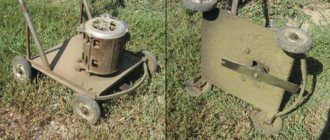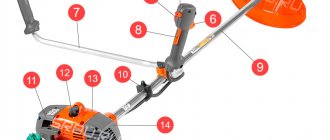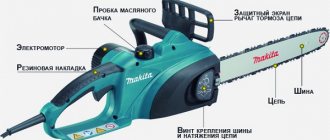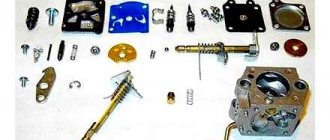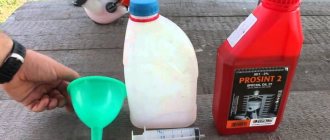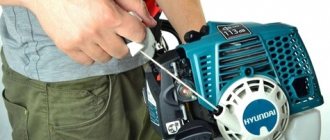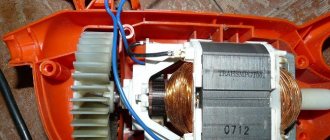The use of various electrical devices greatly simplifies the performance of many types of work, but unfortunately, all complex products break sooner or later. Electric trimmer failure
will lead not only to the inability to carry out work in the garden, but also to significant financial expenses for repairs. It is possible to significantly save money and increase your own knowledge of how this equipment works if you repair the trimmer yourself. Before you begin this type of work, you should carefully study the operating principle of this type of household appliance.
Trimmer coil structure
Mower heads for trimmers are available in many designs. both simple and complex. The picture below shows a semi-automatic trimmer head from a disassembled Husqvarna mower.
This type of head is present in the configuration of most gas mowers and electric trimmers, such as Stihl (Stihl), Patriot (Patriot), Champion (Champion), Bosch (Bosch), Huter (Huter) and others. The mower head is quite simple. It consists of the following parts:
- Mow the base of the head;
- Button for semi-automatic cord feeding;
- A reel (spool) that is filled with fishing line;
- Spring;
- Eyes. the fishing line comes out through them;
- Trimmer head cover;
- Fishing line (cord).
The following photo also shows simpler trimmer heads.
All these attachments do not allow you to change the length of the mowing line in semi-automatic mode (after pressing a button). If the cord breaks, the mower must be stopped and replaced manually.
Common problems with electric trimmers
Electric trimmers differ from gasoline devices in a more simplified design. Conventionally, the electric scythe is divided into mechanical and electrical parts. Accordingly, the same groups of problems that occur with this equipment are identified.
Most breakdowns cannot be visually detected. To do this you will need to use various devices. Visually you can determine the following:
To find out which part broke in other cases, you will need to disassemble the electric scythe and sequentially check the most likely options. At the same time, pay attention to external manifestations of deviations from the normal operation of the device. They help determine the cause.
Repairing an electric trimmer will require the following equipment and tools:
Electric scythes often do not work due to reasons not directly related to them, but caused by a decrease in the supply voltage in the network or the inoperative state of the outlet used.
Basic coil malfunctions
Users of electric trimmers and hedge trimmers often encounter problems with semi-automatic mowers. Coil malfunctions can be as follows:
- The line does not spread automatically;
- The cord involuntarily comes out of the reel.
line does not expand automatically
If the line does not lengthen by lightly touching the trimmer reel button to the ground, the reasons for this may be the following.
Option 1. there was a bite, i.e. Clip cord between turns. This problem usually occurs if the user winds the line onto the reel with an uneven winding cross-section or winds it with insufficient tension. In the latter case, when the mower rotates at high speed under the influence of centrifugal force, the cord begins to compress, which leads to possible twisting of the mowing line. To fix the problem, you will have to disassemble the reel into a trimmer and rewind the cord correctly, that is, in equal turns with good tension.
Option 2. The ends are too short and stick out from the head. When hitting the ground, the rod may not fall out if its ends protruding from the head are not long enough (short). In this case, the centrifugal force is not enough to stretch the line. Therefore, it is necessary to stop the unit (turn off the engine or disconnect the electric trimmer from the power supply) and pull out the line manually by first pressing the button.
Option 3. The line is soldered inside the mower. This causes the reel to stop and not spin when the button is pressed. This is mainly due to several reasons: poor quality of the cord, overheating of the reel during continuous operation of the machine and the impact of the mowing line on hard objects.
- In the first case, the cord from third-party manufacturers may be made of low-quality and fusible materials that cannot withstand mechanical and thermal loads. Therefore, it is necessary to give preference to “branded” fishing lines.
- But if you still bought a fishing line of unknown quality, and it often gets soldered during operation, you can follow the example of some users who, after filling the cord into the reel, wet it with either silicone grease (from a spray can) or mineral oil. This procedure significantly reduces the likelihood of soldering between turns of the mowing line.
- The line can also be soldered if it hits a hard object (stone, fence, dry branch, etc.) during mowing. As a result, it stretches a little and reaches the head at high speed. The cord heats up due to friction, and its coils stick together. The only thing you can do to solve this problem is to open the trimmer spool and rewind the line.
The cord involuntarily lengthens
There are situations when a trimmer user notices very rapid line consumption. However, he never pressed the button on the ground to extend the line. The reason that the fishing line involuntarily lengthens, cutting off the special knife on the body of the device, may be a lack of spring in the mowing head. Often, novice mower users, when trying to load line into the reel, forget to install the compression spring in the head or even lose it when opening the lid, and in the future they will not even know about its existence.
READ How to Change Line on a Viking 700 Electric Trimmer
ICE malfunctions and ways to eliminate them
Most often, the trimmer's internal combustion engine fails due to:
An internal combustion engine breakdown manifests itself in different ways, for example, the appearance of extraneous noise during trimmer operation, or the inability to increase the speed to the value stated in the technical documentation.
Attention! Failure of the internal combustion engine can be caused not only by its damage, but also by the occurrence of factors that impede the operation of the engine. One of them is the cooling fins or starter grill becoming clogged with grass and dirt. The air and fuel filters can also become clogged. Only after these defects have been eliminated can you proceed to repairing the internal combustion engine.
The appearance of extraneous noise during engine operation
A suddenly uncharacteristic knock that appears, reminiscent of metal hitting metal, indicates that the engine has overheated or the fuel supply has stopped. The defect can be eliminated by briefly turning off the engine and checking the presence of fuel in the tank. If the knocking comes from the engine itself, then the reason lies in the wear of parts of the cylinder-piston group or crankshaft bearings. In this case, the sound is eliminated by replacing worn parts. It is possible that in this case the crankshaft may need to be replaced.
CPG repair
Failure of CPG parts, as a rule, occurs due to violation of the oil change schedule or lack of oil. This is especially true for two-stroke engines, where a lubricant is added to gasoline. After all, as engine oil ages, it loses its lubricating properties, and the resulting sediment makes it completely unsuitable for use . Another reason that can cause such a malfunction is insufficient fuel.
CPG malfunctions are considered the most complex and expensive - after all, repairs may require replacing all parts of the piston group (cylinder, rings, piston, seals, etc.). It is better to entrust this kind of operation to specialists, because incompetent intervention can “ruin” the engine completely. How the CPG is repaired can be seen in the video:
Ignition system repair
One of the most serious failures of this system is considered to be the failure of the ignition coil. However, before you worry about replacing it, you need to check the functionality of the remaining parts - after all, the cause of the malfunction may well be related to a breakdown of the switch or starter. But first of all, you need to test the condition and performance of the spark plug - make sure that its housing is intact and free of contamination.
Attention! All work related to removing the spark plug must be carried out with the engine turned off and cooled down. In addition, this procedure requires a special key.
So, to remove the spark plug, you must first disconnect the high-voltage cable and then unscrew it with a special key. Next, the spark plug is inspected for deposits and carbon deposits, and then cleaned with white spirit or brake fluid. In cases where the spark plug is faulty, it is replaced with a new one, after which it is installed in place and carefully tightened with a wrench.
Related repairs of other trimmer components
Another component whose performance affects the functioning of the lawn mower’s engine is the carburetor. Moreover, an ordinary user can only disassemble and clean it from dirt and deposits with his own hands.
Advice! If, after finishing work, the engine starts and immediately stalls, then the carburetor must be adjusted, and this procedure must be entrusted to a specialist.
Checking and cleaning the carburetor is carried out in the following order:
The performance of the engine also depends on the serviceability of the starter, an integral element of which is the ignition coil. After all, the trimmer engine starts after the flywheel “dogs” engage with the teeth of the ignition coil. This happens when the starting cable is tensioned, a more vigorous tension of which leads to the engine starting. At the same time, too sharp a start, during which the “dogs” hit the coil, can contribute to the destruction of the latter . The fact that the ignition coil has failed is indicated by the absence of a spark at the spark plug.
Attention! If the ignition coil breaks, the starter assembly must be replaced.
Summarizing the above, it should be noted the importance of observing the operating conditions recommended by the trimmer manufacturer, the proportions of the combustible mixture, as well as the regularity and type of maintenance. Violation of these requirements may affect the operation of the most important component of the trimmer - the motor, which is very difficult to repair with your own hands, but is possible with certain technical knowledge and tools. Although in this case, in order not to aggravate the situation, it is recommended to use the paid services of a specialist.
Trimmer Husqvarna 128R on Yandex Market
Trimmer Makita EBH341U on Yandex Market
Trimmer Huter GGT-2500S on Yandex Market
Source
How to remove the reel and replace the line
Trimmer owners, mostly beginners, are confused, bordering on panic, when the need arises to change the cutting tool or line in the reel. Too often, when trying to unscrew the head of a lawnmower, users simply render it unusable, unaware that it is unscrewing in the opposite direction. . To avoid this, if you need to replace the tool, it is recommended that you read the step-by-step instructions below.
How to fix a trimmer yourself
Trimmer repairs should be carried out as soon as possible when the first signs of breakdown appear, so that minor faults do not lead to more serious problems. All models are characterized by the presence of the following main components and structural elements: drive system (motor), transmission devices, working part (knife or fishing line), belts and handles. Failure can occur in any part, but some components fail much more often than others.
Lawn mowers powered by gasoline or electricity (as well as different models from different manufacturers) differ in design and the nature of the problems. Some of them can be easily fixed with your own hands, while others will require more extensive repairs or contact a service center.
Video: How to Disassemble an Electric Trimmer
- Before inserting line into the spool, turn off the hedge trimmer motor or turn off the electric trimmer to avoid injury that could occur if the cutting tool accidentally spins.
- Unscrew the attached attachment and the transmission shaft. To do this, you need to fix the shaft by aligning the holes on the washer and on the axle and inserting a metal rod or screwdriver.
- Unscrew the nozzle. You should know that the threads on the shaft remain. Therefore, turn the trimmer coil to the right, that is, clockwise.
- Disassemble the mowing head. Most often, the main cover is attached with clips. To remove it, you will need to lower these clips onto the body by squeezing the edges of the cover. If your trimmer has a semi-automatic mower with a button on the bottom, be careful to disassemble the attachment as you may lose the spring that sometimes pops out when you remove the cover.
- Cut the required amount of fishing line. Typically its length is 5 meters. Use cord with the diameter specified in the tool manual. It is not recommended to exceed the maximum diameter of the mowing line, as this will increase the load on the engine and increase gas mileage.
- Find the middle of a piece of cord by folding it in half. You will receive a loop.
- Cut the coils into special grooves (there may be holes). Insert a loop of fishing line into this groove.
- Wind the line onto the reel by turning it counterclockwise. It is necessary to fill the cord as evenly as possible, turns must take place without overlap and with good tension. After winding is completed, leave free ends of the fishing line about 20 cm long and secure them in the grooves on the sides of the reel.
- Assemble the mowing head. Before you finally assemble the attachment, be sure to install the spring and washer (if available). Insert the spool into the housing and push the ends of the cord through the holes or eyes.
- Replace the cover and secure it with the latches.
- Screw the nozzle back onto the gearbox shaft, also securing it with a screwdriver. Turn the trimmer spool to the left (counterclockwise).
READ How to Properly Prepare a Mixture for a Petrol Trimmer
Malfunctions and their elimination
Electric and gasoline trimmers experience typical breakdowns and malfunctions. For devices powered by an internal combustion engine, these are:
Electrical units have specific breakdowns:
For simple problems, you can repair the trimmer yourself.
Why won't the trimmer start?
The most common reason that the unit does not start is the use of low-quality fuel. Choosing gasoline grades lower than AI-92 can damage the lawn mower. If high-quality fuel is used, you need to look for other reasons. To do this, all components and systems are carefully checked. The following are subject to verification:
The device may not start after a long period of inactivity. Before turning on the trimmer, you need to carefully study the operating instructions. The solution to many problems is indicated in it.
If it stalls when you press the gas
There are several reasons why the trimmer stalls when you press the gas:
To avoid the described problems with the lawn mower, you need to carefully monitor the condition of the device and its components. Timely cleaning and washing of the unit and spare parts can increase its service life.
Starter breakdowns
The most difficult starter breakdown occurs when the rope breaks and winds around the flywheel of a running engine. As a result, the spring may burst and the pulley may break off. In this case, only a complete replacement of the spare part will help. Such a breakdown rarely occurs. More often it happens:
In this case, it is easy to repair the starter yourself. The manufacturer has prepared step-by-step instructions for this.
Gearbox repair
Caring for the brush cutter gearbox involves timely lubrication of the unit. The absence of this can lead to rapid wear of the gears and jamming of the gear module.
Main malfunctions of the trimmer gearbox:
Most gearbox problems are associated with bearing failure.
This happens due to the use of low quality lubricant or its complete absence. Another reason for gearbox failure is operating the trimmer to the limit of its capabilities and getting foreign objects. To replace a faulty bearing, the gearbox is disassembled.
Features of repair of electric models
Electric models of trimmers operating from the mains contain several main blocks:
Each electric trimmer unit has specific problems. In the mechanical part, they depend on the presence of a fishing line used as a cutting element. Reasons for termination:
You can identify problems with the electrical part of the electric scythe using special tools:
To fix problems you need a blowtorch.
Electrical damage:
Is it possible to make a coil on a trimmer with your own hands?
- Take a piece of plywood or PCB and draw a circle on it with a diameter of about 14 cm.
- Cut the disc with a jigsaw or hacksaw.
- Drill a hole in the center of the disk corresponding to the diameter of the gearbox shaft. Be sure to install the washer before installing the disc onto the shaft.
- You can fasten small corners along the edges of the disk or make 1-2 holes on opposite sides. These will be used to thread their line.
- To secure the fishing line to the plywood, you can screw several screws.
This homemade mowing attachment is mounted on a walnut shaft. Tightening or unscrewing the nut without locking the shaft does not work. To replace the cord, you just need to unscrew the screws, insert a piece of fishing line of the required length and press again.
You can also make a mowing attachment to attach a fishing line from sheet metal. You can understand how to do this from the following video.
Source
We all need to improve our personal plots of land in the summer and, of course, provide a beautiful view of the site:
- In the country;
- In a private house,
Here is a photo with the technical data of the electric trimmer. The trimmer repair will be accompanied by personal photographs detailing the repair.
Features of self-repair of gasoline and electric grass trimmers
Trimmers are simple devices for cutting grass that have replaced ordinary scythes. This type of household appliance is powered by an internal combustion engine or electricity. During operation, some parts of the unit may fail. Trimmer repairs are carried out independently. In case of complex breakdowns, order diagnostics and troubleshooting at the service center.
Disassembling the trimmer
Proceed to disassembling the electric trimmer:
First, disconnect the two connected halves of the trimmer, the control handle from the contact connection with the engine itself.
Two photographs \photo No. 2, photo No. 3 \ show the sequence of separating the engine from the control handle.
Next you need to check and diagnose. control knobs \ photo No. 4 \. Disassemble this part and perform diagnostics for individual electrical connections\photo #5\.
Check with an indicator screwdriver
To check the electrical connections we need a simple tool. indicator screwdriver.
READ How to Disassemble the Makita 9910 Sander
Photo 6 shows a detachable contact connection with the control handle. To check the electrical circuit between the plug contacts \photo No. 7\ and the removable contacts \photo No. 6\, you can close the plug with the fingers of your left hand and alternately connect the tip of the indicator screwdriver to the removable contacts.
In case of integrity, in the absence of any gap \ photo No. 9 \ in the electrical connections, the indicator lamp of the screwdriver lights up, that is, the electrical circuit is thus closed on the LED lamp of the indicator screwdriver.
When performing this diagnostic, it is also necessary to close the potentiometer contact \ press the contact \, as shown in Figure No. 8.
We tested one half of the electric trimmer/control handle. The handle of the hand trimmer is in good condition and then we need to check the other half of the trimmer which consists of the electric motor and capacitor.
Diagnostics using a multimeter
We need such a test. digital multimeter. You can also use a multimeter pointer or a device such as an ohmmeter. it doesn't make any difference at all.
Set the digital multimeter in the measurement range of the least resistance, connect the probes of the device to the plug-in connector \ motor output contacts \. The device in this example\photo No. 10\ demonstrates unity with us. The display of the device indicates an open circuit in the engine electrical circuit.
We need to understand in more detail what could be causing the problem, and of course we need to disassemble the two connected parts of the housing where the motor circuit is located.
Checking the commutator motor
Check the commutator motor first. Connect the probes of the device to the contacts of the graphite brushes \ photo No. 11 \, the device display shows the resistance as shown in the photo. 29 ohms. Reading the device indicates the integrity of the stator windings of the commutator motor.
Next, we'll look at what could be causing the problem. We diagnose the wires, output contacts of the detachable connection from the electric motor with the contacts of the graphite brushes.
Using the fingers of one hand, we wrap the two output contacts from the electric motor and touch the contacts of the graphite brushes with the tip of an indicator screwdriver \ photo No. 12, photo \ 13 \.
And when checking the data of the electrical sections, the cause of the trimmer malfunction is revealed.
In the contact connection, the wire\photo No. 13\contact is broken by a graphite brush. Troubleshooting is not difficult. To do this, etch the contact connection with the wire and the contact connection using a graphite brush with soldering acid \ photo No. 14 \. Next, apply a small layer of tin using a soldering iron \ photo No. 15 \ and solder the wire to the contact of a graphite brush \ photo No. 16 \.
Thus, the cause of the “electric line trimmer” malfunction was identified and eliminated. As you can see, such reasons may be minor breakdowns that can be identified without much difficulty.
I wish all my friends a successful repair when troubleshooting various electrical equipment.
Source
Malfunctions of electric motors and ways to eliminate them
The fact that the trimmer motor has failed is indicated by:
In order to revive the motor of an electric hand scythe with your own hands, its owner must have certain knowledge in the field of electrical engineering, understand the structure of the electric motor and have experience in troubleshooting problems that arise during the operation of complex household products.
Important! Diagnosis and troubleshooting begin with a visual inspection and testing the power cable with a multimeter. If damage is detected, they are eliminated.
Next you need to make sure there is voltage
220V to the motor contacts when you press the power button. If there is voltage, this indicates that it is the motor that has failed. Otherwise, the power button is faulty, which is best replaced.
Bearings
Most often, an electric motor loses its performance due to faulty bearings. In normal condition, the rotor should rotate freely inside the stator. However, the lack of lubricant in the bearings, its depletion or dirt getting inside can cause difficulty rotating the rotor. In some situations it may even jam. In addition, strong noise when the motor is running may indicate that the bearings are broken and require replacement.
External damage
Before starting repairs, it is recommended to carefully inspect the electric motor for damage. These include:
Identified defects are eliminated if possible. After this, it is recommended to thoroughly wipe the commutator plates and brushes with a cloth moistened with alcohol. If the graphite brushes are very worn, they are replaced with new ones. If there are potholes or burnt areas on the collector plates, the latter is subjected to mechanical processing followed by polishing.
Windings
The magnetic core of the electric motor is made of special high-strength steel, and its failure can only be caused by extreme loads. Therefore, when repairing an electric motor, all attention is paid to the integrity of the windings and their insulation, as well as reliable contact between the mating parts . The integrity of the windings is checked as follows:
Important! The multimeter should show a resistance value of no more than 100 ohms.
In the case when the device shows infinite resistance, it is recommended to rotate the motor shaft without removing the probes from the brush contacts. If the multimeter shows a resistance ranging from 10 to 40 Ohms, then the stator winding is intact, and if it is less than 5 Ohms, then it has an interturn short circuit, which usually occurs when the motor is severely overheated.
